中国的计划生育政策演变(英文)共18页文档
- 格式:ppt
- 大小:648.00 KB
- 文档页数:18
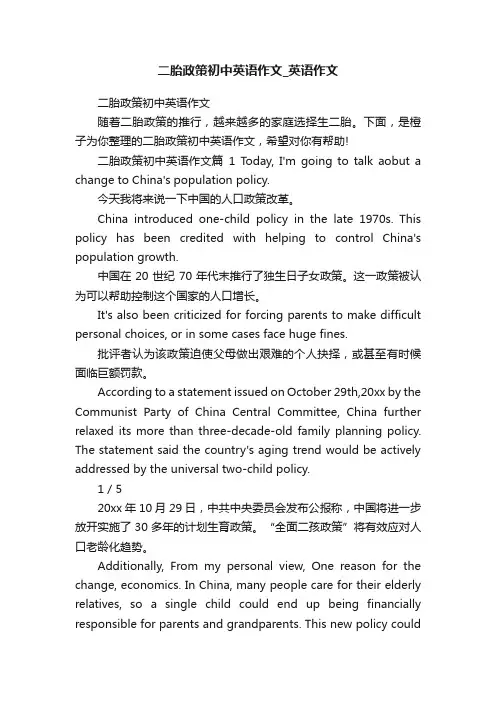
二胎政策初中英语作文_英语作文二胎政策初中英语作文随着二胎政策的推行,越来越多的家庭选择生二胎。
下面,是橙子为你整理的二胎政策初中英语作文,希望对你有帮助!二胎政策初中英语作文篇1 T oday, I'm going to talk aobut a change to China's population policy.今天我将来说一下中国的人口政策改革。
China introduced one-child policy in the late 1970s. This policy has been credited with helping to control China's population growth.中国在20世纪70年代末推行了独生日子女政策。
这一政策被认为可以帮助控制这个国家的人口增长。
It's also been criticized for forcing parents to make difficult personal choices, or in some cases face huge fines.批评者认为该政策迫使父母做出艰难的个人抉择,或甚至有时候面临巨额罚款。
According to a statement issued on October 29th,20xx by the Communist Party of China Central Committee, China further relaxed its more than three-decade-old family planning policy. The statement said the country's aging trend would be actively addressed by the universal two-child policy.1 / 520xx年10月29日,中共中央委员会发布公报称,中国将进一步放开实施了30多年的计划生育政策。
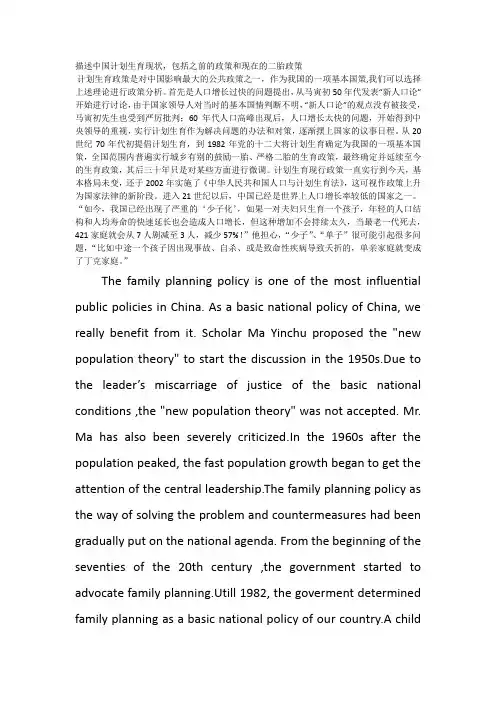
描述中国计划生育现状,包括之前的政策和现在的二胎政策计划生育政策是对中国影响最大的公共政策之一,作为我国的一项基本国策,我们可以选择上述理论进行政策分析。
首先是人口增长过快的问题提出,从马寅初50年代发表“新人口论”开始进行讨论,由于国家领导人对当时的基本国情判断不明,“新人口论”的观点没有被接受,马寅初先生也受到严厉批判;60年代人口高峰出现后,人口增长太快的问题,开始得到中央领导的重视,实行计划生育作为解决问题的办法和对策,逐渐摆上国家的议事日程。
从20世纪70年代初提倡计划生育,到1982年党的十二大将计划生育确定为我国的一项基本国策,全国范围内普遍实行城乡有别的鼓励一胎、严格二胎的生育政策,最终确定并延续至今的生育政策,其后三十年只是对某些方面进行微调。
计划生育现行政策一直实行到今天,基本格局未变,还于2002年实施了《中华人民共和国人口与计划生育法》,这可视作政策上升为国家法律的新阶段。
进入21世纪以后,中国已经是世界上人口增长率较低的国家之一。
“如今,我国已经出现了严重的‘少子化’,如果一对夫妇只生育一个孩子,年轻的人口结构和人均寿命的快速延长也会造成人口增长,但这种增加不会持续太久,当最老一代死去,421家庭就会从7人剧减至3人,减少57%!”他担心,“少子”、“单子”很可能引起很多问题,“比如中途一个孩子因出现事故、自杀、或是致命性疾病导致夭折的,单亲家庭就变成了丁克家庭。
”The family planning policy is one of the most influential public policies in China. As a basic national policy of China, we really benefit from it. Scholar Ma Yinchu proposed the "new population theory" to start the discussion in the 1950s.Due to the leader’s miscarriage of justiceof the basic national conditions ,the"new population theory" was not accepted. Mr. Ma has also been severely criticized.In the 1960s after the population peaked, the fastpopulation growth began to get the attention of the central leadership.The family planning policy as the way of solving the problem and countermeasures had been gradually put on the national agenda. From the beginning of the seventies of the 20th century ,the government started to advocate family planning.Utill1982, the govermentdeterminedfamily planningas a basic national policyof our country.A childwas encouraged in one family commonlynationwide and strict child birth policy was put out,which finally determined the family planning policy.However,after entering the twenty-first Century, China has been one of the countries with a low population growth rate in the world.There are also other hidden troubles.Forinstance,if a couple only haveone child, young population structure and the average life expectancy of the rapid extension can also cause the population growth.But this increase will not last too long.When the old generation die, familiynumbers will sharply reduce.Also if a child dies due to accident, there are no one to provide for the aged.So some places open two child policy now.。
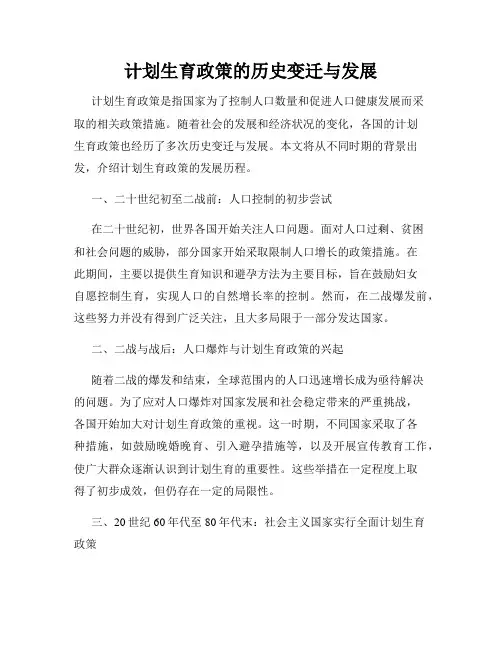
计划生育政策的历史变迁与发展计划生育政策是指国家为了控制人口数量和促进人口健康发展而采取的相关政策措施。
随着社会的发展和经济状况的变化,各国的计划生育政策也经历了多次历史变迁与发展。
本文将从不同时期的背景出发,介绍计划生育政策的发展历程。
一、二十世纪初至二战前:人口控制的初步尝试在二十世纪初,世界各国开始关注人口问题。
面对人口过剩、贫困和社会问题的威胁,部分国家开始采取限制人口增长的政策措施。
在此期间,主要以提供生育知识和避孕方法为主要目标,旨在鼓励妇女自愿控制生育,实现人口的自然增长率的控制。
然而,在二战爆发前,这些努力并没有得到广泛关注,且大多局限于一部分发达国家。
二、二战与战后:人口爆炸与计划生育政策的兴起随着二战的爆发和结束,全球范围内的人口迅速增长成为亟待解决的问题。
为了应对人口爆炸对国家发展和社会稳定带来的严重挑战,各国开始加大对计划生育政策的重视。
这一时期,不同国家采取了各种措施,如鼓励晚婚晚育、引入避孕措施等,以及开展宣传教育工作,使广大群众逐渐认识到计划生育的重要性。
这些举措在一定程度上取得了初步成效,但仍存在一定的局限性。
三、20世纪60年代至80年代末:社会主义国家实行全面计划生育政策20世纪60年代至80年代末,一些社会主义国家开始实行全面的计划生育政策。
主要目标是通过控制人口数量,实现经济发展和社会进步。
这些国家采取了一系列政策措施,如晚婚晚育、计划怀孕、节育手术等,并通过宣传教育和医疗卫生服务的全面发展,为人民提供生育控制的支持和帮助。
这些政策导致了人口出生率的显著下降,并为经济发展提供了基础。
然而,在一些国家,全面计划生育政策也带来了一些问题和挑战。
由于政策执行力度过大或不合理,导致一些非预期的后果,如性别比例失衡、人口老龄化等。
因此,从80年代末开始,一些国家逐步放松计划生育政策,转向更加灵活和适应时代发展需要的政策措施。
四、90年代至今:多样化的计划生育政策与现代人口管理自20世纪90年代以来,全球范围内开始出现计划生育政策的多样化趋势。
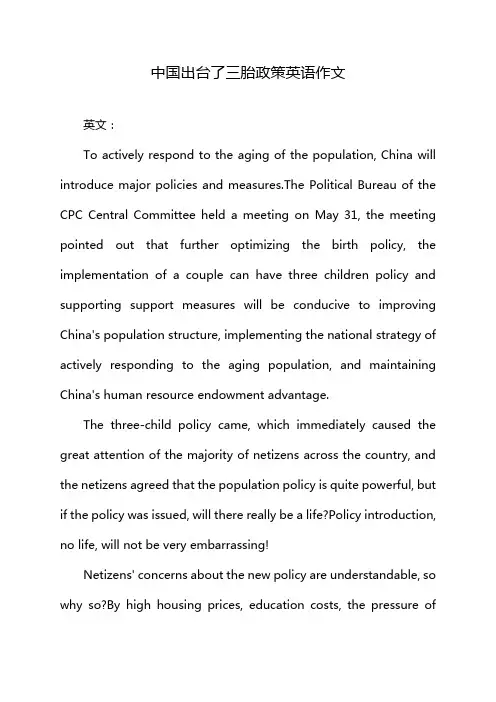
中国出台了三胎政策英语作文英文:To actively respond to the aging of the population, China will introduce major policies and measures.The Political Bureau of the CPC Central Committee held a meeting on May 31, the meeting pointed out that further optimizing the birth policy, the implementation of a couple can have three children policy and supporting support measures will be conducive to improving China's population structure, implementing the national strategy of actively responding to the aging population, and maintaining China's human resource endowment advantage.The three-child policy came, which immediately caused the great attention of the majority of netizens across the country, and the netizens agreed that the population policy is quite powerful, but if the policy was issued, will there really be a life?Policy introduction, no life, will not be very embarrassing!Netizens' concerns about the new policy are understandable, so why so?By high housing prices, education costs, the pressure ofemployment, medical costs, many young people are not interested in birth, from the seventh national census related data can see: the national population of 1411.78 million, compared with the sixth national census in 2010, increased 72.06 million, up 5.38%, the average annual growth rate of 0.53%, from 2000 to 0.04% than average.The total fertility rate of women of childbearing age in China was 1.3, which is already at a low level.This is mainly affected by the continuous decrease in the number of women of childbearing age and the gradual weakening of the "two-child" effect.From these data show that contemporary young people have a very low desire to have children. In particular, it needs to say that the change in their concept of marriage and childbearing has also caused many young people not to have children, or many young people do not get married. So it is difficult to solve the fertility problem only by the adjustment of the fertility policy.Of course, some people believe that the introduction of the three-child policy is good for two groups of people: one is the high family income.This group has the idea of a big family, thinking that a large population, a prosperous career, a prosperous future, raisingand educating children, so they choose to live, not only three, but some even more.The other is that the life is relatively poor, backward ideas, can not control their own reproductive behavior.As mentioned in the news in the past, some families are particularly poor, but they have very many children, and some even have seven or eight children. They did not take having children as a burden, and even think that with more children, the country will take care of them, just in this way, they have been giving birth.Even if the quality of life is very bad, they get used to the poor days and hard days, there is no ambitious idea. Without adjusting the birth policy, they still have birth.Birth pressure is very big, and contemporary young people chat, mostly just say that have one, give birth to two is very rare, even if the life is good, the change of their ideas, they have two or three, basically have no such idea.Today's adjustment of the birth policy will be more or less cold.Of course, when the three-child policy comes out, we cannot question the positive significance of its existence. With the increase of the national housing price control policy, the pace of medicalreform follows译文:积极应对人口老龄化,我国将出台重大政策举措。
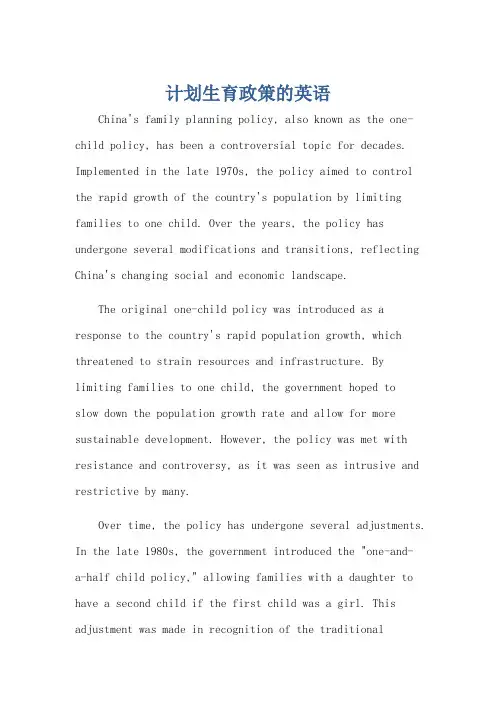
计划生育政策的英语China's family planning policy, also known as the one-child policy, has been a controversial topic for decades. Implemented in the late 1970s, the policy aimed to control the rapid growth of the country's population by limiting families to one child. Over the years, the policy has undergone several modifications and transitions, reflecting China's changing social and economic landscape.The original one-child policy was introduced as a response to the country's rapid population growth, which threatened to strain resources and infrastructure. Bylimiting families to one child, the government hoped toslow down the population growth rate and allow for more sustainable development. However, the policy was met with resistance and controversy, as it was seen as intrusive and restrictive by many.Over time, the policy has undergone several adjustments. In the late 1980s, the government introduced the "one-and-a-half child policy," allowing families with a daughter to have a second child if the first child was a girl. This adjustment was made in recognition of the traditionalpreference for male children in China, which led to a gender imbalance in the population.More recently, the government has further relaxed the policy, allowing families to have two children regardless of gender. This "two-child policy" was implemented in 2015, reflecting a shift in China's population dynamics and economic priorities. With the aging population and decreasing labor force, the government is now focused on maintaining a stable population growth rate while also promoting economic growth and social well-being.The impact of the family planning policy has been far-reaching. On the one hand, it has successfully slowed down the population growth rate, allowing for more sustainable development. The policy has also contributed to the improvement of women's status in society, as it has given them more control over their reproductive rights. On the other hand, the policy has also led to some negative consequences, such as the gender imbalance and the aging population.The gender imbalance issue is particularly concerning. Because of the traditional preference for male children,families with a daughter often choose to have a secondchild in hopes of having a son. This has led to a significant excess of male children in the population, which could have negative social and economic consequences in the future.The aging population is another challenge that China faces as a result of the family planning policy. With fewer children per family, there are fewer young people to support the elderly population. This has put a strain on the country's social welfare system and healthcare infrastructure.Overall, the family planning policy has had a significant impact on China's population dynamics andsocial structure. While it has achieved some positive results, such as slowing down population growth and improving women's status, it has also created new challenges that need to be addressed. The government is now 面临着在维持人口稳定增长和促进经济社会发展之间找到平衡的重要任务。
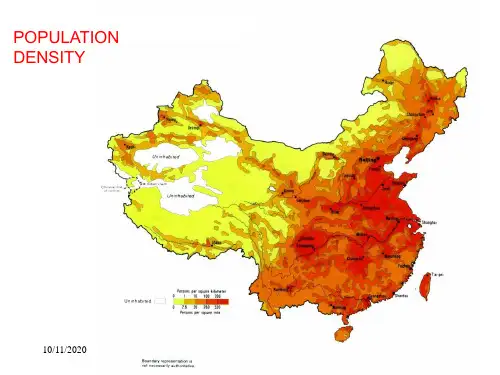

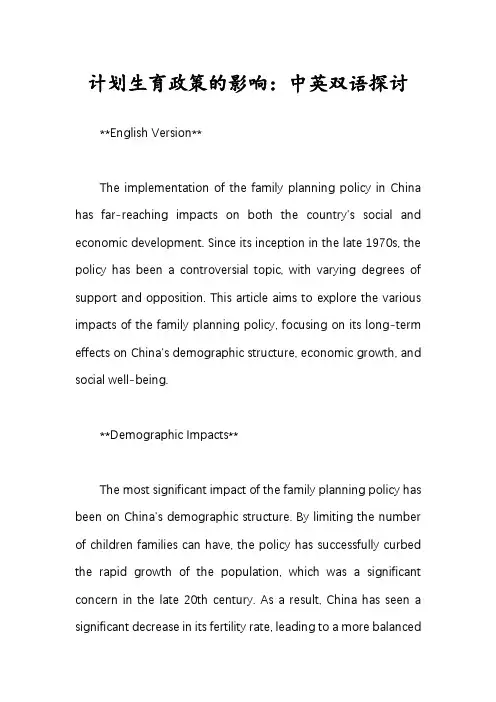
计划生育政策的影响:中英双语探讨**English Version**The implementation of the family planning policy in China has far-reaching impacts on both the country's social and economic development. Since its inception in the late 1970s, the policy has been a controversial topic, with varying degrees of support and opposition. This article aims to explore the various impacts of the family planning policy, focusing on its long-term effects on China's demographic structure, economic growth, and social well-being.**Demographic Impacts**The most significant impact of the family planning policy has been on China's demographic structure. By limiting the number of children families can have, the policy has successfully curbed the rapid growth of the population, which was a significant concern in the late 20th century. As a result, China has seen a significant decrease in its fertility rate, leading to a more balancedage structure and a reduction in population pressure on resources and infrastructure.However, the policy has also led to some demographic challenges. The one-child policy, in particular, has resulted in a gender imbalance, with a higher ratio of boys to girls due to a preference for male children. This has led to social issues such as increased marriage pressure and gender-based discrimination. Furthermore, the aging population is becoming a growing concern, as the number of working-age individuals decreases relative to the elderly population.**Economic Impacts**The family planning policy has also had significant impacts on China's economic growth. By controlling the population growth, the policy has allowed the country to invest more resources in education, healthcare, and infrastructure development. This has fostered economic growth and development, particularly in the urban areas.However, the policy has also had some negative economic impacts. The one-child policy, for instance, has led to a decrease in labor supply, as families have only one child to contribute to the workforce. This has put pressure on the labor market and may have contributed to rising labor costs. Additionally, the aging population may lead to a decrease in economic productivity and an increase in social welfare expenditure.**Social Impacts**The social impacts of the family planning policy are also diverse. On the one hand, the policy has helped to improve the quality of life for many families by reducing the financial and emotional burden of raising multiple children. It has also empowered women by giving them more control over their reproductive choices.However, the policy has also led to some social tensions. The gender imbalance caused by the one-child policy has led to increased competition and stress among young people, particularly men. Additionally, the aging population has led to arise in elderly care needs, putting pressure on the social welfare system and family relationships.**Conclusion**Overall, the family planning policy in China has had both positive and negative impacts on the country's social and economic development. While it has successfully curbed population growth and fostered economic growth, it has also led to demographic challenges and social tensions. As China moves forward, it will be crucial to address these challenges and find a balance between population control and social well-being.**Chinese Version**中国计划生育政策的深远影响自20世纪70年代末实施以来,中国的计划生育政策对国家的社会经济发展产生了深远的影响。
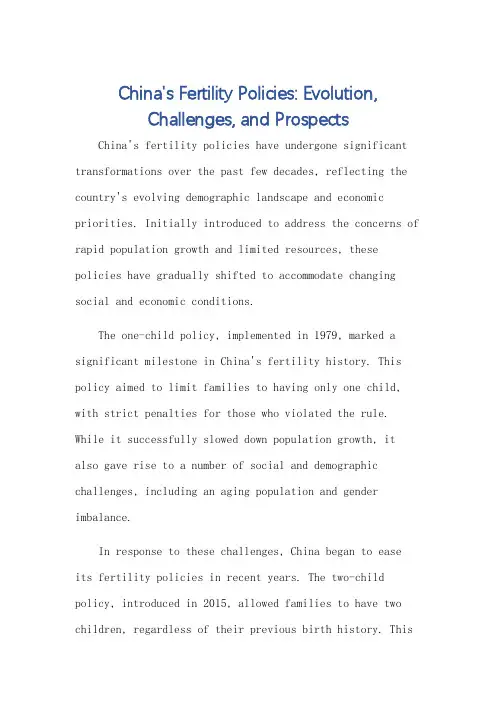
China's Fertility Policies: Evolution,Challenges, and ProspectsChina's fertility policies have undergone significant transformations over the past few decades, reflecting the country's evolving demographic landscape and economic priorities. Initially introduced to address the concerns of rapid population growth and limited resources, these policies have gradually shifted to accommodate changing social and economic conditions.The one-child policy, implemented in 1979, marked a significant milestone in China's fertility history. This policy aimed to limit families to having only one child, with strict penalties for those who violated the rule. While it successfully slowed down population growth, it also gave rise to a number of social and demographic challenges, including an aging population and gender imbalance.In response to these challenges, China began to easeits fertility policies in recent years. The two-child policy, introduced in 2015, allowed families to have two children, regardless of their previous birth history. Thiswas followed by the three-child policy in 2021, which further liberalized the fertility restrictions, allowing families to have up to three children.Despite these policy changes, China still faces a number of challenges in its fertility landscape. One of the main concerns is the low fertility rate, which has been below the replacement level for several years. This is attributed to various factors, including the high cost of raising children, changing social norms, and women's increasing participation in the workforce.To address these challenges, the Chinese government has implemented a range of measures to encourage fertility. These include providing financial incentives for families with more children, expanding maternity and childcare services, and promoting gender equality in the workplace. However, the effectiveness of these measures remains to be seen, as changing social and economic conditions may continue to influence fertility rates.Looking ahead, China's fertility policies are likely to continue to evolve in response to changing demographic and economic realities. While the three-child policy representsa significant step towards liberalization, it remains to be seen whether it will be sufficient to address the country's fertility challenges. Given the complexity of these issues, a comprehensive approach that addresses the underlying causes of low fertility is likely to be necessary.**中国生育政策:演变、挑战与前景**中国生育政策在过去几十年中经历了重大变革,这反映了中国不断变化的人口状况和经济优先事项。

China Adopts Universal Two-Child Policy (1)重要资料,可以直接用。
Ever Changing, Improving: China's Family Planning (计划生育)Policy (17)China Adopts Universal Two-Child PolicyChina further relaxed its more thanthree-decade-old family planning policy, according to a statement issued on Thursday by the Communist Party of China Central Committee.Roughly 90 million Chinese couples will become eligible to have a second child.It's the latest move by the authorities to fine-tune the family planning policy, amid the nation's changingdemo-graphics, which could lead to potential labor shortages (潜在的劳动力短缺)in the future if not addressed.(处理)The statement said the country's ageing trend(老龄化趋势)would be actively addressed by the universal(普遍的)two-child policy, and that China would continue to stick to the family planning policy as a basic State interest.(国家利益)Yuan Xin, a population scientist at Nankai University in Tianjin, who sits on(开庭审理;成为…的一员;旁听;列席)an expert panel (专家团)of the National Healthand Family Planning Commission, said scrapping the family planning policy remained a long way off."The new initiative will be much better received among the Chinese people than the previous(以前的,先前的)policy relaxation and will help boost (推动,促进)China's labor supply in the long run," he said.In late 2013, the central government relaxed (放松,放宽)the family planning policy, allowing couples to have a second child in situations(在。
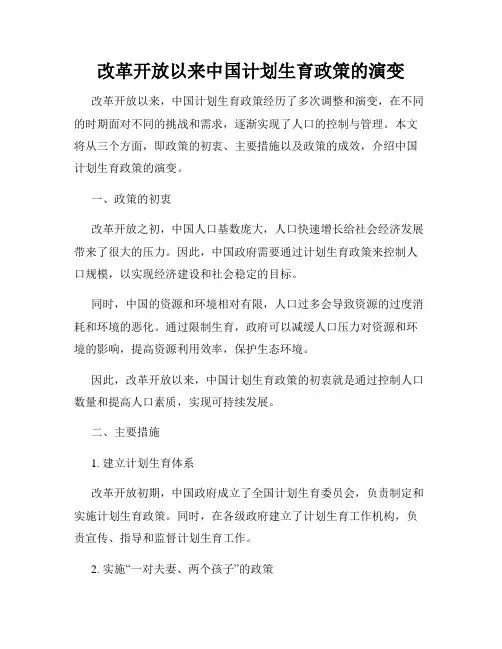
改革开放以来中国计划生育政策的演变改革开放以来,中国计划生育政策经历了多次调整和演变,在不同的时期面对不同的挑战和需求,逐渐实现了人口的控制与管理。
本文将从三个方面,即政策的初衷、主要措施以及政策的成效,介绍中国计划生育政策的演变。
一、政策的初衷改革开放之初,中国人口基数庞大,人口快速增长给社会经济发展带来了很大的压力。
因此,中国政府需要通过计划生育政策来控制人口规模,以实现经济建设和社会稳定的目标。
同时,中国的资源和环境相对有限,人口过多会导致资源的过度消耗和环境的恶化。
通过限制生育,政府可以减缓人口压力对资源和环境的影响,提高资源利用效率,保护生态环境。
因此,改革开放以来,中国计划生育政策的初衷就是通过控制人口数量和提高人口素质,实现可持续发展。
二、主要措施1. 建立计划生育体系改革开放初期,中国政府成立了全国计划生育委员会,负责制定和实施计划生育政策。
同时,在各级政府建立了计划生育工作机构,负责宣传、指导和监督计划生育工作。
2. 实施“一对夫妻、两个孩子”的政策1980年代,中国开始实施“一对夫妻、两个孩子”的政策。
这一政策规定,城镇居民夫妻要晚婚晚育,农村居民夫妻要合理安排生育,限制家庭人口数量,控制总人口规模。
3. 实施节育措施为了确保计划生育政策的顺利实施,中国政府实施了一系列节育措施。
包括推广避孕药具和器械的使用,普及计划生育知识,开展节育手术等。
4. 奖励和处罚政策为了鼓励符合政策的夫妇生育少子女,政府给予一孩夫妻生育奖励和优待,例如减免教育费用、提供住房等。
同时,对超生的夫妻实施处罚措施,包括罚款、限制享受社会福利等。
三、政策的成效改革开放以来,中国计划生育政策取得了显著成效。
首先,人口规模得到了有效控制。
根据统计数据,改革开放以前,中国人口增长率较高,多年来一直保持在2%以上。
而实施计划生育政策后,人口增长率逐渐下降,目前已降至较低水平。
其次,出生人口素质得到了提高。
由于政策的实施,夫妻在生育子女时更加慎重,注重孩子的教育和养育。
我国计划生育政策的演变
我国计划生育政策的演变
我国计划生育政策始于20世纪70年代,是为解决人口过剩问题而实施的一种措施。
该政策主要包括晚婚晚育、一夫一妻、独生子女等方面的内容。
当时,我国人口持续快速增长,已经成为制约经济发展和社会进步的严重问题。
因此,政府采取了控制人口数量和质量的措施,以保障社会和经济稳定。
随着时代的变迁,我国计划生育政策也不断发展和完善。
2002年,政策进行了修订,提出了“计划生育一代、倡导两孩”理念,允许某些情况下夫妻可生育两个孩子。
在2016年,政策又进行了全面放开二孩的修订,鼓励有条件的夫妻生育二孩。
而到了2021年,最新政策进一步延长了产假和陪产假。
50多年的实践证明,计划生育政策在不断完善和调整中逐渐发挥了重要作用,通过控制人口数量和质量,维持了我国人口与资源、环境的均衡。
同时,相应的政策措施也为保障妇女权益、加强优生优育提供了重要保障。
随着社会发展和人口结构不断变化,计划生育政策也必须跟进发展,不断完善和改进。
而我们,也应该透过政策的革新,更加关注人口与社会与经济的互动,研究我们的家庭与个人在面对政策调整时的应对策略。
人口与计划生育法2012版原文英文回答:The "Population and Family Planning Law" was promulgated on December 27, 2001, and formally implemented on March 1, 2002. The law was revised on December 29, 2015, and formally implemented on January 1, 2016. The revised law is the current version of the Population and Family Planning Law.The main contents of the revised Population and Family Planning Law are as follows:1. The state advocates and guides citizens to practice family planning. Citizens have the right to practice family planning, and the state shall provide guidance, services, and technical support.2. The state advocates late marriage and late childbearing, and encourages one child per couple. Coupleswho have a child may have a second child if they meet the relevant legal requirements.3. The state protects the reproductive rights of women and guarantees their right to safe and effective family planning services.4. The state prohibits sex-selective abortion and gender discrimination against girls.5. The state supports the development of family planning services and provides funding for family planning programs.6. The state establishes a population and family planning supervision and inspection system to ensure the implementation of the law.7. The state shall commend and reward individuals and organizations that have made outstanding contributions to family planning.The revised Population and Family Planning Law reflects the changes in China's demographic situation and the government's policy on population and family planning. The law is designed to promote the healthy and sustainable development of China's population and to protect the rights and interests of women and children.中文回答:《人口与计划生育法》2012版于2001年12月27日公布,并于2002年3月1日正式施行。
我国计划生育政策发展变化历程我国计划生育政策变化历程从1971年的一个不少,两个正好,三个多了,到提倡一对夫妇只生育一个孩子从单独二孩政策顺利落地,到全面实施一对夫妇可生育两个孩子,我国的生育政策从产生的那一天起就始终在实践中不断调整和完善。
1971年,国务院批转《关于做好计划生育工作的报告》,强调要有计划生育。
在当年制定四五计划中,提出一个不少,两个正好,三个多了。
1973年12月,第一次全国计划生育汇报会提出晚、稀、少的政策。
晚指男25周岁、女23周岁以后结婚,女24周岁以后生育; 稀指生育间隔为3年以上; 少指一对夫妇生育不超过两个孩子。
1978年3月,第五届全国人民代表大会第一次会议通过的《中华人民共和国宪法》第五十三条规定国家提倡和推行计划生育。
计划生育第一次以法律形式载入我国宪法。
为完成在20世纪末把人口总量控制在12亿以内的目标,1978年,中央下发《关于国务院计划生育领导小组第一次会议的报告》,明确提出提倡一对夫妇生育子女数最好一个,最多两个。
1980年9月25日,党中央发表《关于控制我国人口增长问题致全体共产党员、共青团员的公开信》,提倡一对夫妇只生育一个孩子。
1982年,《中共中央、国务院关于进一步做好计划生育工作的指示》,提出照顾农村独女户生育二胎。
1984年,中央批转国家计生委党组《关于计划生育工作情况的汇报》,提出对农村继续有控制地把口子开得稍大一些,按照规定的条件,经过批准,可以生二胎;坚决制止大口子,即严禁生育超计划的二胎和多胎,即开小口、堵大口。
2002年9月施行的《中华人民共和国人口与计划生育法》明确规定,国家稳定现行生育政策,鼓励公民晚婚晚育,提倡一对夫妻生育一个子女;符合法律、法规规定条件的,可以要求安排生育第二个子女。
进入21世纪后,我国人口形势发生了重大变化。
劳动力持续问题、老龄化问题、人口结构性问题等开始显现。
14个省份相继取消了生育第二胎的生育时间间隔等。